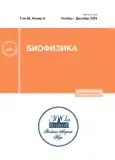Зависимость интенсивности высвобождения кислорода из эритроцитов от степени их кластеризации в сладжи
- Авторы: Пономарев И.А1,2, Гурия Г.Т1,2
-
Учреждения:
- Национальный медицинский исследовательский центр гематологии Минздрава России
- Московский физико-технический институт
- Выпуск: Том 68, № 6 (2023)
- Страницы: 1210-1219
- Раздел: Статьи
- URL: https://journals.rcsi.science/0006-3029/article/view/249696
- DOI: https://doi.org/10.31857/S0006302923060121
- EDN: https://elibrary.ru/ROWONW
- ID: 249696
Цитировать
Полный текст
Аннотация
Об авторах
И. А Пономарев
Национальный медицинский исследовательский центр гематологии Минздрава России;Московский физико-технический институтМосква, Россия;Долгопрудный, Московская обл., Россия
Г. Т Гурия
Национальный медицинский исследовательский центр гематологии Минздрава России;Московский физико-технический институт
Email: guria@blood.ru
Москва, Россия;Долгопрудный, Московская обл., Россия
Список литературы
- C. Wang and A. S. Popel, Math Biosci., 116 (1), 89 (1993). doi: 10.1016/0025-5564(93)90062-f
- E. Ortiz-Prado, J. F. Dunn, J. Vasconez, et al., Am. J. Blood Res., 9 (1), 1 (2019).
- A. Sircan-Kucuksayan, M. Uyuklu, and M. Canpolat, Physiol. Meas., 36, 2461 (2015). doi: 10.1088/09673334/36/12/2461
- A. M. Pilotto, A. Adami, R. Mazzolari, et al., J. Physiol., 600 (18), 4153 (2022). doi: 10.1113/JP283267
- N. Tateishi, N. Maeda, and T. Shiga, Circ. Res., 70 (4), 812 (1992). doi: 10.1161/01.RES.70.4.812
- A. G. Tsai, P. C. Johnson, and M.Intaglietta, Physiol. Rev., 83, 933 (2003). doi: 10.1152/physrev.00034.2002
- D. C. Poole, T. I. Musch, and T. D. Colburn, Eur. J. Appl. Physiol., 122, 7 (2022). doi: 10.1007/s00421-021-04854-7
- H. Kohzuki, S. Sakata, Y. Ohga, et al., Jap. J. Physiol., 50, 167 (2000). doi: 10.2170/jjphysiol.50.167
- N. Tateishi, Y. Suzuki, I. Cicha, and N. Maeda, Am. J. Physiol. - Heart and Circulatory Physiology, 281, H448 (2001). doi: 10.1152/ajpheart.2001.281.1.H448
- M. Uyuklu, H. J. Meiselman, and O. K. Baskurt, Clin. hemorheology and microcirculation, 41 (3), 179 (2009). doi: 10.3233/CH-2009-1168
- A. Semenov, A. Lugovtsov, P. Ermolinskiy, et al., Photonics, 9 (4), 1 (2022). doi: 10.3390/photonics9040238
- R. J. Tomanek, Anatom. Record, 305 (11), 3199 (2022). doi: 10.1002/ar.24951
- D. C. Poole and T. I. Musch, Function, 4 (3), zqad013 (2023). doi: 10.1093/function/zqad013
- A. Melkumyants, L. Buryachkovskaya, N. Lomakin, et al., Thrombosis and Haemostasis, 122 (01), 123 (2022). doi: 10.1055/a-1551-9911
- A. Gupta, M. V. Madhavan, K. Sehgal, et al., Nature Medicine, 26 (7), 1017 (2020). doi: 10.1038/s41591-020-0968-3
- S. Chien, in The red blood cell, Ed. by D. M. Surgenor (Acad. Press, London, New York, San Francisco, 1975), pp. 1031-1133.
- A. N. Beris, J. S. Horner, S. Jariwala, et al., Soft Matter, 17 (47), 10591 (2021). doi: 10.1039/D1SM01212F
- D. A. Fedosov, M. Peltomaki, and G. Gompper, Soft Matter, 10, 4258 (2014). doi: 10.1039/C4SM00248B
- N. Z. Piety, W. H. Reinhart, P. H. Pourreau, et al., Transfusion, 56, 844 (2016). doi: 10.1111/trf.13449
- T. J. McMahon, Front. Physiol., 10 (1417), 1 (2019). doi: 10.3389/fphys.2019.01417
- J. T. Celaya-Alcala, G. V. Lee, A. F. Smith, et al., J. Cerebral Blood Flow & Metabolism, 41 (3), 656 (2021). doi: 10.1177/0271678X20927100
- И. Н. Бронштейн и К. А. Семендяев, Справочник по математике для инженеров и учащихся втузов, (Совместное издание издательств "Тойбнер", Лейпциг, и "Наука", Москва, 1981), сс. 169-170.
- P. B. Canham, Journal of Theoretical Biology, 26, 61 (1970). doi: 10.1016/S0022-5193(70)80032-7
- T. Shiga, N. Maeda, and K. Kon, Crit. Rev. in Oncology/Hematology, 10 (1), 9 (1990). doi: 10.1016/1040-8428(90)90020-S
- T. Tajikawa, Y. Imamura, T. Ohno, et al., J. Biorheology, 27, 1 (2013). doi: 10.1007/s12573-012-0052-9
- T. W. Secomb, Annu. Rev. Fluid Mechanics, 49, 443 (2017). doi: 10.1146/annurev-fluid-010816-060302
- В. Л. Воейков, Успехи физиол. наук, 29, 55 (1998).
- A. Rabe, A. Kihm, A. Darras, et al., Biomolecules, 11, 1 (2021). doi: 10.3390/biom11050727
- Yu. I. Gurfinkel, O. A. Korol, and G. E. Kufal, SPIE, 3260, 232 (1998). doi: 10.1117/12.307096
- I. Cicha, Y. Suzuki, N. Tateishi, and N. Maeda, Am. J. Physiol. - Heart and Circulatory Physiology, 284 (6), H2335 (2003). doi: 10.1152/ajpheart.01030.2002
- Y. Arbel, S. Banai, J. Benhorin, et al., Int. J. Cardiol., 154 (3), 322 (2012). doi: 10.1016/j.ijcard.2011.06.116
- M. A. Elblbesy and M. E. Moustafa, Int. J. Biomed. Sci., 13 (2), 113 (2017).
- R. N. Pittman, Microcirculation, 20 (2), 117 (2013). doi: 10.1111/micc.12017
- A. E. Lugovtsov, Y. I. Gurfinkel, P. B. Ermolinskiy, et al., in Biomedical Photonics for Diabetes Research, Ed. by A. V. Dunaev and V. V. Tuchin (CRC Press, London, New York, 2023), pp. 57-79. DOI: 10.1201/ 9781003112099
- E. Hysi, R. K. Saha, and M. C. Kolios, J. Biomed. Optics, 17 (12), 125006 (2012). doi: 10.1117/1.JBO.17.12.125006
- T. H. Bok, E. Hysi, and M. C. Kolios, Biomed. Optics Express, 7 (7), 2769 (2016). doi: 10.1364/BOE.7.002769
Дополнительные файлы










